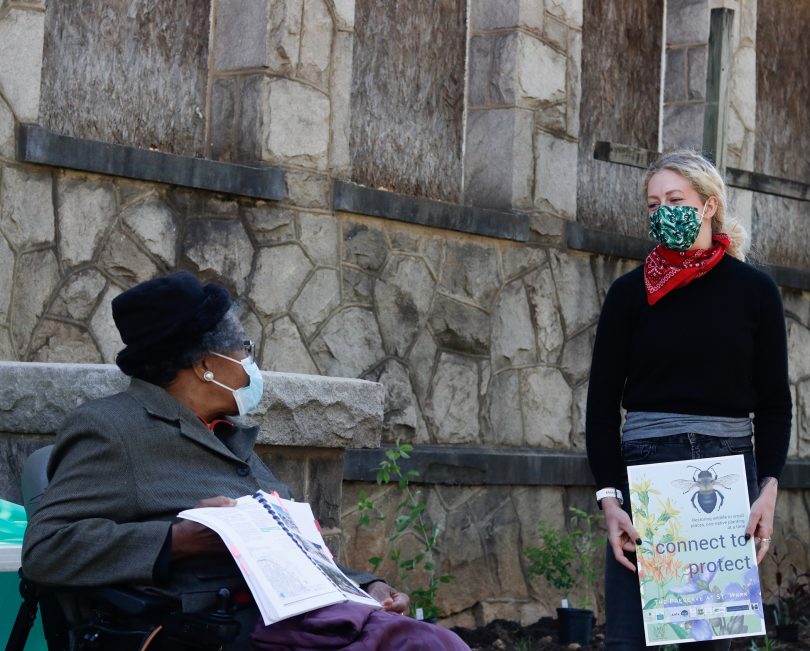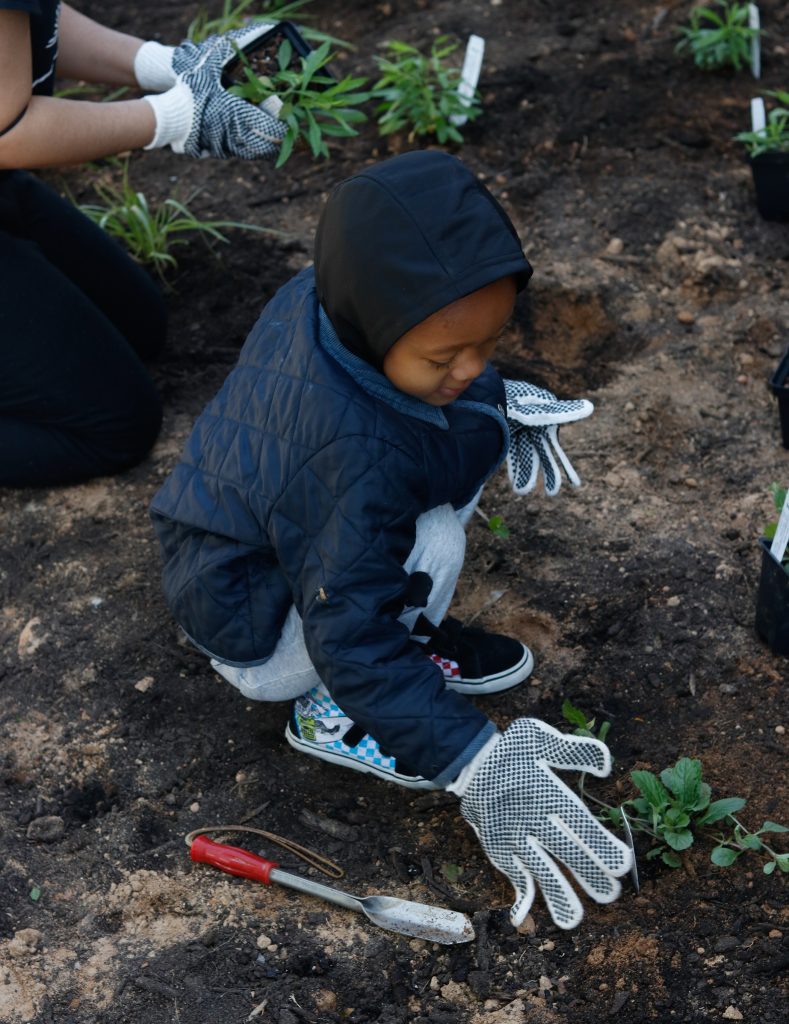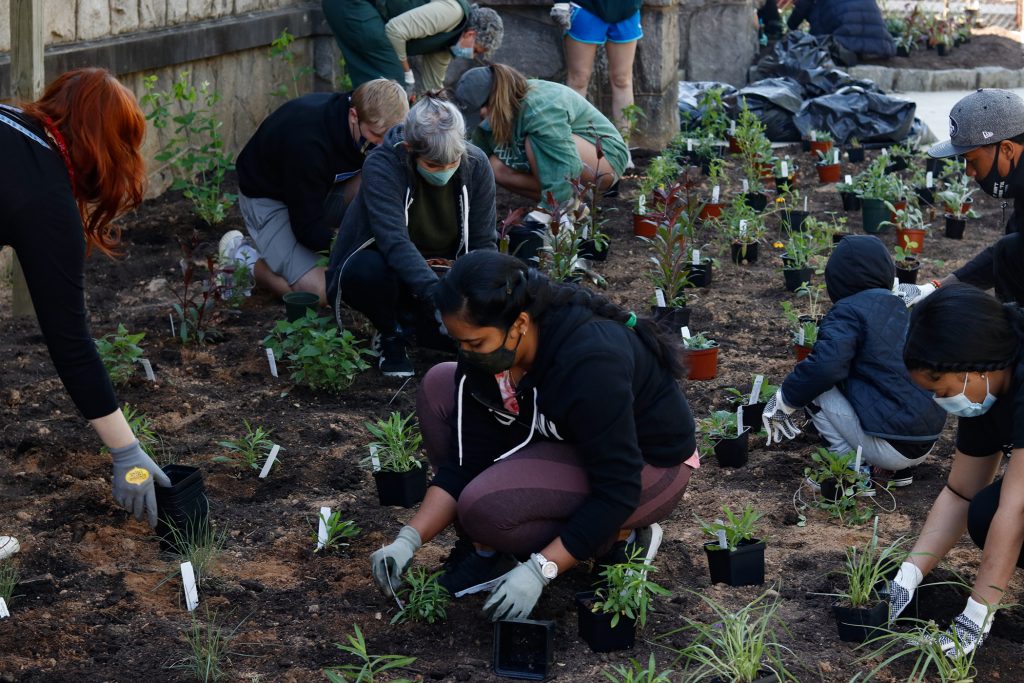The preserved remains of the old St. Mark’s A.M.E. Church rise up in the center of Atlanta’s English Avenue neighborhood like an ancient ruin.
Soon, they will be flanked by native grasses, wildflowers and shrubs, installed on Earth Day by volunteers, with guidance from the State Botanical Garden of Georgia at the University of Georgia. The west side Atlanta church is at the heart of a neighborhood revitalization project that includes pollinator gardens and green space. The Rev. Winston Taylor, who owns the church remains, hopes to make it a cultural gathering spot for the community.
“Green spaces can function on many levels,” said Jenny Cruse-Sanders, director of the State Botanical Garden, who participated in the Earth Day planting. “They create sanctuaries for people who need accessible outdoor areas that are safe, and they can support pollinators and other wildlife in an urban environment.”
Lauren Muller, conservation outreach coordinator for the State Botanical Garden, led the planting effort, which included more than 20 species of native plants propagated at the University of Georgia. Residents of the English Avenue community, college students, USDA Forest Service partners and city of Atlanta employees were among the volunteers who turned out on that chilly morning to put the plants in the ground.
Local resident and activist Mamie “Mother” Moore helped organize the pollinator planting, part of the Westside Land Use Framework Plan.
“This project is geared to spark the movement of pollinator planting in the neighborhood, and Lauren’s design qualifies us for the Rosalyn Carter Butterfly Trail,” Moore said.
Designed by Muller, the garden includes plants that take into account the insect life cycle and include larval host plants for caterpillars as well as bee balm and mint to provide seeds for birds.
“This garden will be an opportunity for people to see these species that are integral to ecosystems in Georgia,” Muller said. “It’s inspirational to see that a relatively small garden like this can have an impact.”
The garden is part of the State Botanical Garden’s Connect to Protect Program (https://outreach.uga.edu/connect-to-protect/). It is also within the G Pollinator Project, the brainchild of Dennis Krusac, an endangered species specialist with the USDA Forest Service and his biologist wife Jackie Belwood. What began as a 10-by-10-foot garden at a school has grown to include hundreds of pollinator gardens statewide.
Cruse-Sanders met Krusac and Shannon Lee from the Conservation Fund Atlanta office, about a decade ago when they first worked in the English Avenue and Vine City communities to establish the neighborhoods first two greenspaces.
She recalls planting 140 milkweed plants with partners at the Greening Youth Foundation on a site not far from the old St Mark’s. Within a month, the plants, which are important to monarch butterflies, had attracted 65 monarch caterpillars.
“For the monarchs to find that spot in the middle of the city just goes to show that these efforts make a difference,” Cruse-Sanders said.
The new pollinator garden is a joint project between the State Botanical Garden of Georgia, a division of UGA’s public service and outreach unit, the city of Atlanta, the Westside Future Fund and the USDA Forest Service.
The Conservation Fund paid for the pollinators planted at the old church on Earth Day. Elizabeth Beak, a food systems planner for the city of Atlanta, was there representing Mayor Keisha Lance Bottoms goal of having 85% of Atlanta residents living within a half mile of fresh, affordable food.
“Fresh food access is a really big piece of our work,” said Elizabeth Beak, food systems planner for the city of Atlanta. “There are community gardens every few blocks in this area and bees and bee habitats help pollinate every three bites that we take.”
Cruse-Sanders’ neighbor in Athens, Yvonne Studevan, came to the planting as a volunteer with a rich history of the A.M.E. faith. Studevan is a seventh-generation descendant of Richard Allen, who founded the first Bethel A.M.E. church in Philadelphia in 1794. AME churches, she said, were designed to be within walking distance of predominantly African American neighborhoods.
“I think this garden will help revitalize and bring life into the neighborhood,” Studevan said.












